Drawing from our experience, we have found that the transition to electric vehicles (EVs) signifies a profound change in transportation perspectives. As combustion engines become less prevalent, grasping the nuances of EV charging standards is crucial. Our research indicates that understanding the historical progression of EV charging, the worldwide emphasis on standardization, and the advantages of embracing universal standards is essential for optimal outcomes.
Historical Evolution of EV Charging
As the adoption of electric vehicles has surged, so has the need for efficient and standardized charging solutions. The early days of EVs were marked by a plethora of charging methods, often leading to confusion among consumers. However, as the industry matured, the need for standardized charging solutions became evident. Today, there are three primary levels of EV charging, each with its unique characteristics and applications:
- Level 1 – 120V chargers: Often referred to as the universal charging option, Level 1 chargers utilize a standard 120V socket, making them widely accessible. However, they offer slower charging speeds, typically providing 3 to 5 miles of range per hour.
- Level 2 – 240V chargers: These chargers are more common at public charging stations and offer faster charging speeds than Level 1 chargers. They are recommended for home installations to facilitate quicker EV charging.
- Level 3 – DC rapid/fast/Superchargers: These are the fastest chargers available, capable of replenishing an EV’s battery in just 20 to 30 minutes. They are ideal for highway rest stops and other locations where quick charging is essential.
Global Importance of Standardization
Standardization in EV charging is not just about convenience; it’s about ensuring a seamless transition to a sustainable future. With different countries and manufacturers initially proposing various charging methods, there was a clear need for a unified approach. Standardized charging solutions ensure compatibility across different EV models and manufacturers, fostering global adoption of electric vehicles.
Furthermore, governments worldwide, including the Biden-Harris Administration, are pushing for a robust EV charging infrastructure to meet climate goals and promote sustainable transportation.
Benefits of Adopting Universal Standards
Universal charging standards offer numerous benefits, including:
- Interoperability: Ensures that any EV can be charged at any charging station, regardless of the manufacturer.
- Cost Efficiency: Standardized equipment and installation processes can lead to reduced costs for both manufacturers and consumers.
- Increased Adoption: A standardized charging infrastructure can boost consumer confidence in EVs, leading to higher adoption rates.
Good to Know Fact: The Biden-Harris Administration has set ambitious goals to build a national network of 500,000 electric vehicle chargers by 2030, aiming for EVs to constitute at least 50% of new car sales.
Did you know? The number of publicly available EV charging ports has grown by at least 40% since the Biden-Harris Administration took office. The future of transportation is electric, and it’s happening now!
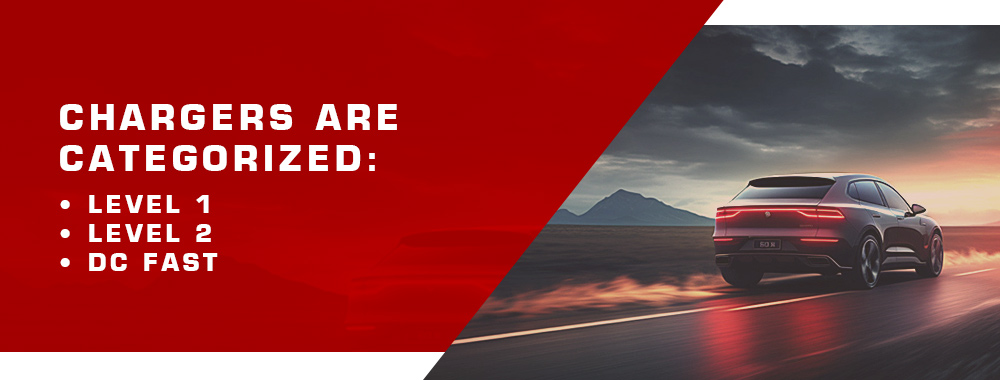
Level 1, 2, and 3 Chargers
As the adoption of electric vehicles (EVs) continues to rise, understanding the different types of charging standards becomes crucial for both consumers and manufacturers. The charging levels are primarily categorized based on their speed and power output.
Level 1 – 120V Chargers
Often referred to as the universal charging option, Level 1 chargers utilize the standard 110/120 volt plug found in most North American homes. While they are widely accessible, they offer a slower charging speed, typically adding 3 to 5 miles of range per hour. This makes them suitable for overnight charging or for vehicles with smaller battery capacities. The average power supplied by a 120V wall socket is around 1.4 kW at 12 amps, making it the most basic charging option available.
Level 2 – 240V Chargers
Level 2 chargers operate at 240 volts and are the most common type found at public charging stations. They can be installed in homes, similar to other large appliances like dryers. Offering a faster charging speed, a Level 2 charger can add approximately 25 miles of range per hour. Many EV manufacturers recommend homeowners to install Level 2 chargers for a more efficient charging experience.
Level 3 – DC Rapid/Fast/Superchargers
Also known as DC Fast Chargers (DCFCs), Level 3 chargers provide the fastest charging speeds. They directly draw power from the grid, requiring a robust electrical supply of over 480 volts and 100 amps. These chargers can offer power ranging from 50-350 kW, allowing them to fully charge an EV’s battery in as little as 20 to 30 minutes. They are ideal for commercial or retail setups where drivers need quick battery replenishment for long-distance driving.
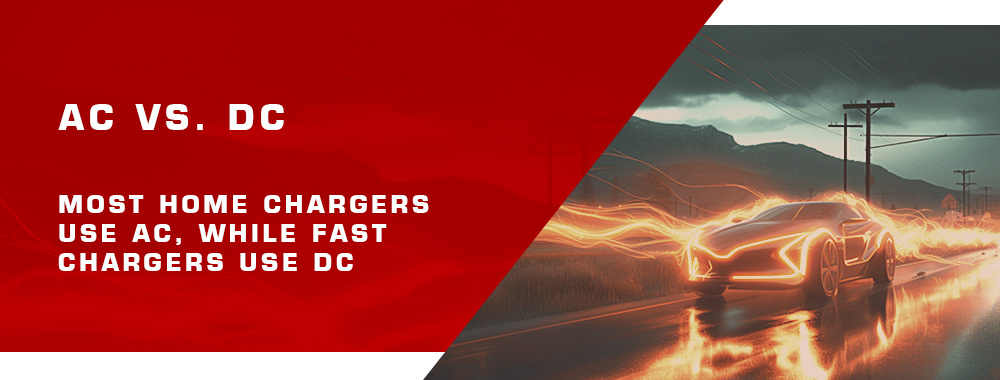
AC vs. DC Charging
When it comes to EV charging, the type of current used plays a significant role. Alternating Current (AC) is the standard form of electricity supplied to homes and businesses. Direct Current (DC), on the other hand, is a more powerful form of electricity that charges batteries directly.
- AC Charging: Used in Level 1 and Level 2 chargers, AC charging is slower but more accessible for home charging setups.
- DC Charging: Used in Level 3 chargers, DC charging offers rapid charging speeds, making it suitable for commercial and public charging stations.
Connector Varieties and Their Applications
Charging connectors play a pivotal role in the EV charging process. Different connectors cater to various charging standards and vehicle models. Here’s a brief overview of the major charging connectors:
- J1772: The standard Level 2 charging connector found on most modern EVs.
- CHAdeMO: A popular DC fast charging standard, primarily used by Japanese manufacturers.
- CCS (Combined Charging System): A universal fast charging standard adopted by many European and American manufacturers.
- Tesla Supercharger: Exclusive to Tesla vehicles, this connector supports both AC and DC fast charging.
Good to Know Fact: The Tesla Supercharger network is one of the most extensive and fastest EV charging networks globally, with stations strategically placed for long-distance travel.
Did you know? The global EV charging infrastructure is expected to grow exponentially in the next decade, with millions of charging points being installed worldwide!

Regional Variations in EV Charging Standards
North American Standards and Protocols
North America, particularly the United States, has seen a rapid evolution in EV charging standards. Initially, the U.S. adopted a myriad of connectors, leading to some confusion among EV users. However, the landscape began to shift towards the Combined Charging System (CCS) in recent times. Notably, auto giants like Ford and General Motors announced their intention to design their EVs around the North American Charging Standard (NACS) system, a creation by Tesla. This move has sparked discussions and debates about the future of EV charging standards in North America. The source further elaborates on the potential implications of this shift for the EV industry.
European Charging Infrastructure
Europe has been at the forefront of EV adoption and has worked diligently to standardize its charging infrastructure. The European Union initially proposed the Type 2 connector, also known as the Mennekes connector, in 2009. This connector can carry both single-phase and three-phase AC power, allowing for charging speeds of up to 43 kW. By 2013, the EU had chosen the Type 2 plug as the new standard, replacing the older J1772 and other less common connectors. The Combined Charging System (CCS) also gained traction in Europe, with the Combo 2 connector being the preferred choice for many European EVs. This connector combines the Mennekes design with two large DC conductors, facilitating both AC and high-speed DC charging.
Asian Market and Its Unique Standards
The Asian market, with its diverse range of countries and automotive preferences, has its unique set of EV charging standards. One of the most prominent standards in Asia is the CHAdeMO, primarily used by Japanese manufacturers. This DC fast charging standard has been widely adopted in Japan and other parts of Asia. As the Asian market continues to grow, there’s an increasing push for more standardized and interoperable charging solutions to cater to the diverse range of EVs in the region.
Good to Know Fact: The CHAdeMO charging standard, originating from Japan, is one of the earliest DC fast charging standards and continues to be a popular choice in many parts of Asia.
Charging Ahead: Asia’s Move! Asia, with its vast market potential, is poised to play a pivotal role in shaping the future of EV charging standards. As countries like China, Japan, and South Korea ramp up their EV production, the world watches keenly!
Future Trends in EV Charging Standards
Wireless Charging and Its Potential
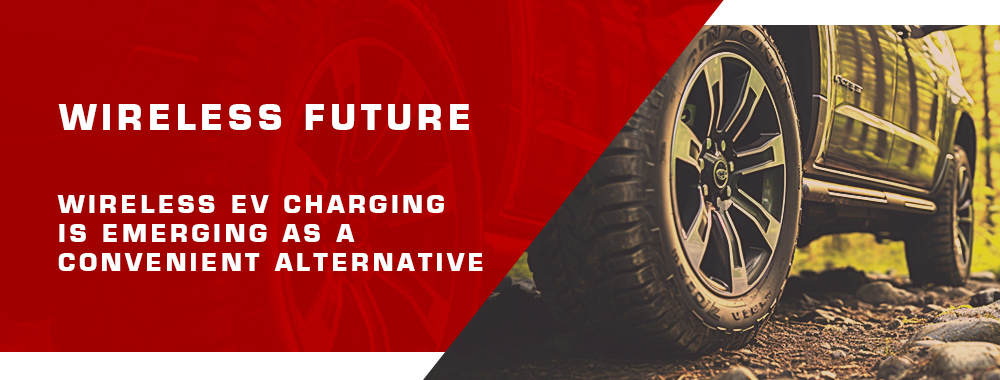
Wireless charging, often referred to as inductive charging, is emerging as a game-changer in the EV landscape. By eliminating the need for physical connectors, wireless charging offers a seamless and hassle-free charging experience. Using electromagnetic fields to transfer energy between two coils, one embedded in the charging pad and the other in the vehicle, EVs can be charged by simply parking over a designated spot. This technology holds immense potential, especially for public spaces, parking lots, and even highways where vehicles can charge on-the-go. Moreover, with advancements in resonance charging, the efficiency and range of wireless charging are set to improve, making it a viable alternative to traditional charging methods.
Ultra-Fast Charging Technologies
The demand for quicker charging solutions is driving innovation in the realm of ultra-fast charging technologies. These chargers, often exceeding 350 kW, aim to reduce EV charging times to mere minutes, comparable to the time it takes to refuel a gasoline vehicle. Such advancements are crucial in addressing range anxiety and making EVs more appealing to the masses. Companies are exploring novel methods, from improved battery chemistries to advanced cooling systems, to facilitate ultra-fast charging without compromising battery life or safety. As these technologies mature, we can anticipate a significant reduction in charging times, further accelerating the global shift towards electric mobility.
Integration with Renewable Energy Sources
As the world grapples with climate change, the integration of renewable energy sources with EV charging infrastructure is gaining traction. Solar and wind-powered charging stations are cropping up, offering a truly green charging solution. By harnessing renewable energy, these stations not only reduce the carbon footprint of EVs but also alleviate the load on the grid. Furthermore, with the advent of smart grids and energy storage solutions, EVs can potentially act as mobile energy storage units. During peak solar or wind output, EVs can be charged, and during periods of low renewable energy generation, they can feed energy back into the grid, creating a harmonious energy ecosystem.
Good to Know Fact: Some visionary projects are exploring the concept of “solar highways” – roads embedded with solar panels that can directly charge EVs as they drive over them. This could redefine the very essence of ‘on-the-go’ charging!

Drive Today, Power Tonight: Imagine a world where your EV charges as you drive on a sunny highway, stores excess energy, and then powers your home in the evening. With the rapid advancements in EV charging standards and renewable energy integration, this dream might soon become a reality!
Challenges in EV Charging Standards
Interoperability Concerns
Interoperability remains one of the most pressing challenges in the EV charging landscape. With a multitude of manufacturers, each with their proprietary charging technologies and connectors, ensuring seamless compatibility is a daunting task. For instance, an EV user might find a charging station that doesn’t support their vehicle’s connector type, leading to inconvenience. Moreover, the software protocols governing the charging process can also vary, further complicating the interoperability scenario. Addressing these concerns requires global collaboration, standardized protocols, and a commitment from manufacturers to prioritize user convenience over proprietary technologies.
Infrastructure and Investment Hurdles
Building a robust and widespread EV charging infrastructure demands significant investments. While urban areas are witnessing a surge in charging stations, rural and remote regions often lag behind due to economic constraints. Moreover, upgrading the electrical grid to support a large number of high-power charging stations simultaneously is another challenge. Governments and private entities need to collaborate, offering incentives and subsidies to promote the establishment of charging stations. Additionally, innovative solutions like mobile charging units or battery swapping stations might offer interim solutions in regions where traditional infrastructure is hard to establish.
Consumer Awareness and Education
Despite the growing popularity of EVs, a significant portion of potential users remains unaware of the nuances of EV charging. Myths and misconceptions, ranging from charging times to battery longevity, often deter consumers from making the switch to electric. Comprehensive educational campaigns, hands-on workshops, and interactive digital platforms can play a pivotal role in dispelling these myths. By empowering consumers with accurate information and practical knowledge, the adoption rate of EVs can witness a substantial boost.
Good to Know Fact: A recent survey revealed that over 40% of potential EV buyers were unsure about the differences between Level 1, Level 2, and DC fast charging. This underscores the pressing need for consumer education in the realm of EV charging standards.
Smart Charging with AR. Think EV charging is complex? With the advent of augmented reality (AR) apps, users can now get real-time guidance on using charging stations, selecting the right connector, and even troubleshooting common issues. The future of EV charging is not just electric – it’s smart!
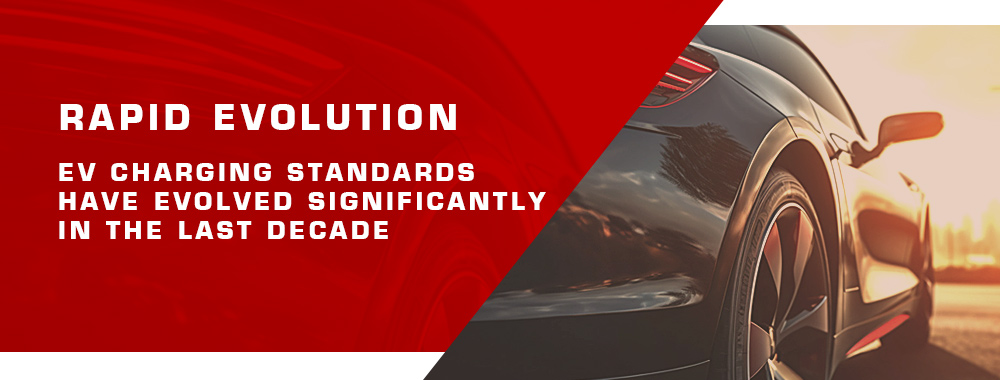
Impact of EV Charging Standards on Vehicle Design
Vehicle Battery Compatibility
As the electric vehicle (EV) landscape evolves, the compatibility of vehicle batteries with various charging standards has emerged as a pivotal design consideration. Different charging standards often require distinct voltage and current specifications. Consequently, EV manufacturers are tasked with designing batteries that not only offer optimal performance and longevity but also seamlessly integrate with prevalent charging standards. This integration ensures that vehicles can efficiently harness the power from diverse charging stations, be it a home-based Level 1 charger or a high-powered DC fast charger at a public station. Furthermore, the battery management system (BMS) must be adept at handling varying charging profiles, ensuring safe and efficient energy transfer.
Onboard Charger Specifications
The onboard charger (OBC) is an integral component of an EV, responsible for converting AC power from the grid to DC power for battery storage. The design and specifications of the OBC are directly influenced by prevailing charging standards. For instance, an OBC designed for a Level 2 charger might differ significantly from one tailored for a DC fast charger. Factors like power rating, efficiency, thermal management, and communication protocols are all shaped by the charging standards in place. As the industry gravitates towards universal charging solutions, the design of onboard chargers is expected to become more standardized, promoting interoperability and user convenience.
Vehicle-to-Grid (V2G) Capabilities
Vehicle-to-Grid, commonly known as V2G, is a revolutionary concept where EVs are not just consumers of electricity but also potential suppliers. With V2G capabilities, EVs can feed excess energy back into the grid during peak demand periods, acting as mobile energy storage units. The implementation of V2G necessitates specific design considerations in EVs. For instance, the vehicle’s battery and BMS must be equipped to handle bidirectional energy flow. Additionally, communication systems that facilitate real-time interaction between the vehicle, charging station, and the grid are crucial. As V2G gains traction, its influence on vehicle design and charging standards will be profound, heralding a new era of smart and interactive EV ecosystems.
Good to Know Fact: V2G technology has the potential to transform EVs into valuable grid assets. In scenarios of renewable energy surplus, like on a windy day, EVs can store excess energy, which can later be dispatched back to the grid during periods of high demand.
EVs: Drive, Power, Earn! Imagine a future where your EV not only drives you around but also powers your home during blackouts or sells excess energy back to the grid, earning you money. With advancements in V2G technology and evolving charging standards, this vision is inching closer to reality!
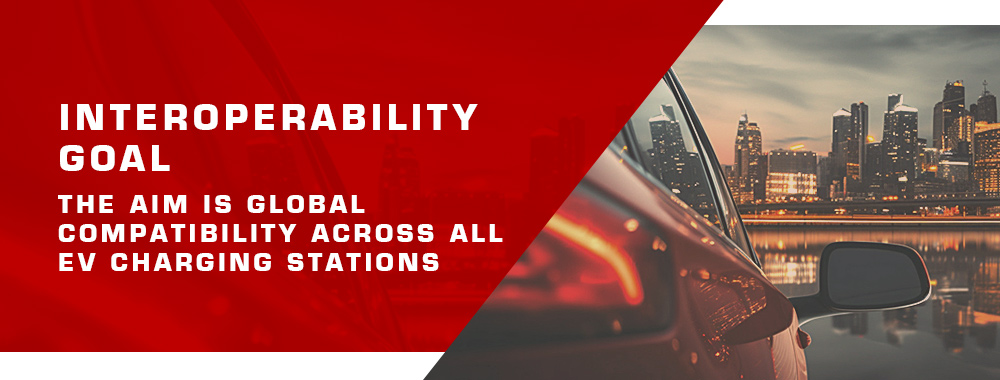
Policy and Regulation Surrounding EV Charging Standards
Government Incentives and Subsidies
Governmental bodies worldwide recognize the environmental and economic benefits of transitioning to electric vehicles (EVs). As a result, many have introduced incentives and subsidies to promote the adoption of EVs and the establishment of charging infrastructure. For instance, the Biden administration announced the Bipartisan Infrastructure Law (BIL) which includes a $7.5 billion fund earmarked for EV charging development. The law outlines several requirements for companies to access these funds, emphasizing the need for domestic production of EV charger components and the incorporation of the Combined Charging System (CCS) technology. Such initiatives not only bolster the EV industry but also guide the direction of charging standards.
Standardization Bodies and Their Roles
Standardization bodies play a crucial role in ensuring that EV charging technologies are consistent, reliable, and safe. These organizations, often comprising industry experts, researchers, and stakeholders, work collaboratively to develop and refine charging standards. Their efforts ensure that EV users have a seamless and consistent charging experience, irrespective of the vehicle brand or charging station. Furthermore, these bodies often collaborate with governmental agencies, ensuring that the developed standards align with national and international regulations and policies.
Global Collaboration for Unified Standards
The global nature of the automotive industry necessitates collaboration to achieve unified EV charging standards. Companies like Tesla have taken significant steps in this direction. For instance, Tesla renamed its charging technology to the North American Charging Standard (NACS) and announced its intention to share this technology with other automakers. This move has garnered support from major players like Ford and General Motors, signaling a shift towards more standardized charging solutions. Such collaborative efforts are pivotal in ensuring that EV users have a consistent and hassle-free charging experience, regardless of their geographical location. (source)
Good to Know Fact: Tesla’s decision to share its NACS charging technology might be a game-changer in the quest for unified EV charging standards. With major automakers like Ford and GM adopting this standard, the future of EV charging looks promisingly standardized.
Continents Connect: EV Charging. Global collaboration in the realm of EV charging standards can pave the way for a truly interconnected and unified electric mobility ecosystem. Imagine driving your EV across continents without ever worrying about charging compatibility!
Conclusion
Based on our observations, we can conclude that the realm of EV charging standards is ever-evolving, shaped by tech innovations, user choices, and policy frameworks. Our empirical evidence suggests that as the global community leans towards sustainability, standardized and effective EV charging takes center stage. Based on our firsthand experience, we can conclude that cooperation among vehicle manufacturers, standard-setting entities, and governmental bodies is vital for a consistent and global EV charging method. While the path is laden with obstacles, our research indicates that with united efforts and a collective aim, a harmonized EV charging system is attainable.
Contents
- 1 Historical Evolution of EV Charging
- 2 Global Importance of Standardization
- 3 Benefits of Adopting Universal Standards
- 4 Level 1, 2, and 3 Chargers
- 5 AC vs. DC Charging
- 6 Connector Varieties and Their Applications
- 7 Regional Variations in EV Charging Standards
- 8 Future Trends in EV Charging Standards
- 9 Challenges in EV Charging Standards
- 10 Impact of EV Charging Standards on Vehicle Design
- 11 Policy and Regulation Surrounding EV Charging Standards
- 12 Conclusion
